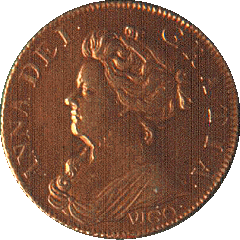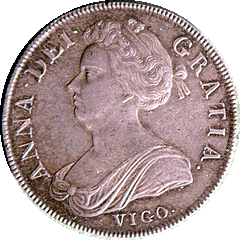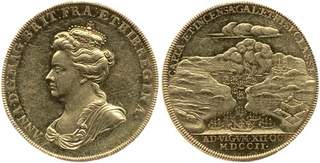THE MYTH OF "VIGO"
Jim Duncan
There are a number of English silver, and a few gold,
coins of 1702-03 which have the word VIGO under Queen Anne's bust. The recent
sale of a 5 guinea piece, guinea and half guinea, all three described as
extremely rare, provides the perfect excuse to research and report the origins
of this privy mark, as far as they can be ascertained! (This was the first
of only two occasions on which a word had been used to identify the provenance
of a metal). Most numismatists will be aware of this 'fabulous' treasure,
and with the other - LIMA - and while their origins are similar, the VIGO
mark has a much better story. LIMA was the second and final use of a word.
Queen Anne, poor lady, came to the throne almost unexpectedly after
the sudden death of William III - her brother in law - in 1702. She was
married to Prince George of Denmark, and seems to me to have led a blighted
life. She had 17 children, all but one of which died in infancy, and she
herself died of cancer. There were even rude rhymes about her, one of which
is suitable for this magazine -
King William thinks all,
Queen Mary talks all
Prince George drinks all
And Princess Anne eats all.
A glance at any coin portrait of Her Gracious Majesty will confirm the
accuracy of this little quatrain!
Of Anne's reign I seem only to
remember that the Union between England and Scotland was achieved. However,
her Royal Navy was not idle, and the rest of the world still had its squabbles.
The War of the Spanish Succession, a major European conflict, began in 1701
over who should succeed the last of the Spanish Hapsburgs, Charles II. He
had bequeathed his possessions to Philip, duc d'Anjou, a grandson of Louis
XIV of France. But the Holy Roman Emperor, Leopold I of Hapsburg, fought
to protect his dynasty's claim to the succession. As the Franco-Hispanic
alliance gathered itself together, other nations, England, Portugal and
the Netherlands, sided with Leopold in his claim.
In July 1702 My
Lords of the Admiralty sent a large Anglo-Dutch force under the command
of Admiral Sir George Rooke and James, Duke of Ormond, to capture Cadiz.
Cadiz is between Portugal and Gibraltar on Spain's southern coast. Some
internal dissension amongst the attackers saw the fleet boasting 25 ships
of the line and 14,000 infantry concede defeat to a Spanish force of 300
infantry and 150 cavalry after a month's siege month between August and
September. Eventually a 'strategic withdrawal' had to be made, and Rooke
sailed for home.
On the way he stopped at Lagos in friendly Portugal
to water his ships, and learned that the Spanish 1702 treasure fleet of
17 ships - believed one of the richest ever assembled - had been diverted
from Cadiz to Vigo Bay, to evade the English fleet. (Vigo is just north
of the Portuguese border, on Spain's Atlantic coast). It arrived in the
Bay on 23 September. Fortunately for the Spanish, a large amount of bullion
and coins had been unloaded before Rooke arrived. What remained was the
bullion, coin and merchandise of private traders. Kings Philip V and Louis
XIV even hatched a cunning plan to acquire this as well as the material
belonging to the Spanish Crown. In this they were thwarted by a pseudo Princess
and free-loader, Marie-Anne de la Trémoille, princesse des Ursins, but I
don't see how this helped her ambition to be a power at Court. (She was
a self-styled princess, and her name Ursins is a corruption of her late
husband's name Orsini - he left her very well off and she sold the title!)
Rooke realised that at Vigo they might be able to salvage something
from the disaster of Cadiz, given some luck. He found the treasure fleet
protected by a Franco-Spanish fleet of about 30 ships. The French commander,
Chateaurenaud, who was in charge of the protection of the treasure, had
already had an argument with the Spanish commander of the treasure ships,
Velasco, and Vigo was a compromise by both men as the best place to seek
safety. Chateaurenaud had fortified the harbour with a boom of masts, which
was covered by guns from forts in the town and on the island of San Símon.
On 23 October Rooke attacked, sending Admiral Thomas Hopsonn on HMS Torbay,
80 guns, to break the boom. The attack was a success - the forts were captured,
the boom broken, and all the Spanish and French ships were burned by their
crews, run aground, sunk or captured. The English and Dutch lost about 800
men against the 2000 lost by the Spanish and French. Rooke was joined by
Admiral Sir Cloudesley Shovel and his fleet from England on 27 October and
they were able to stay in Vigo a number of days to recover as much of the
treasure and other merchandise as possible. They even began to tow the largest
ship, Santo Cristo de Maracaibo, behind HMS Monmouth on
the trip back to England. But bad luck was still with Rooke, the Santo
Cristo struck a rock at the entrance to the harbour and rapidly sank!
However, the victors recovered, in all, from the Spanish ships silver to
the value of £14,000 - or 11 million pieces of eight - or £25 million in
bullion and merchandise. There are a number of versions as to how much was
captured, and also how much the Spanish got ashore before Rooke arrived.
One source reports that £3 million had been unloaded and taken ashore.
There has been much searching since to find if the treasure of the
Santo Cristo de Maracaibo can be recovered from the bottom of Vigo
Bay, and this story even got into Jules Verne's Twenty Thousand Leagues
Under the Sea, when Captain Nemo and his crew obtain money by searching
among the wrecks. For whoever tries there are 70 metres of water and a number
more of mud over the wreck now.
So, good story as far as it goes.
But when I checked The Mint, by Sir John Craig, some questions
arose. A direct quote: "Other windfalls contributed a little (to
the supply of silver); a portion that could not be sold to advantage of
the booty taken at Vigo was sent to be minted in 1704 into coins stamped
with the name of the raid. But the quantity was small." That last
sentence is intriguing, and "a portion that could not be sold to advantage?"
Doesn't sound like 11,000,000 pieces of eight does it? I contacted Spinks
who very kindly supplied me with a copy of a 1968 article by H Kamen of
the University of Warwickshire. Kamen compiled his report using only English
information, which he felt should be the most reliable on English matters,
and much of his material comes from the Public Records Office (PRO) so its
accuracy would appear to be beyond question. Up to this point his version
is pretty much as recorded. (Apart from the princesse!) He does state that
the fleet was 56 vessels strong, 22 of which were Spanish. The rest were
French - but a number of these detached themselves as Europe was neared
and they felt that they were safe on their own. A number were merchant rather
than naval vessels.
Since Vigo Bay was not a regularly used port,
all the officials required to check and receive the assorted cargo had to
be transported there, together with the means of moving the cargo. Absent
were the people who usually managed to pilfer cargoes of their valuables.
So in a way the Spanish were lucky, and they had from 23 September until
23 October to move their goods.
In the attack, it was the job of
the Duke of Ormond to secure the land-based defences, about 2 miles from
the town. Which he did. Kamen adds that the Torbay was set on fire,
losing her foretopmast and about 60 men. The British also captured five
French naval vessels; the biggest, Le Prompt, was 1391 tons, 76
guns and a crew of 500. As a prize she was valued at £1395 10s. The Dutch
also gained a French ship for their navy, and we are reminded that the crew
shared in prize money - whatever could be sold was sold and the money split
up (although silver could NOT be sold to the public!). So the capture of
a good cargo of plate, cochineal, benellos (?), grana silvestra (? cochineal)
and balsam of Peru meant that the English and Dutch sailors stood to gain.
Pepper, cocoa, snuff, indigo and hides were amongst the things lost - and
these were high value items too! But this was of no concern to the Spanish
government, and they lost only two ships, the third being compulsorily borrowed,
and the rest were carrying merchandise and silver belonging to Spanish,
English and Dutch merchants. So that was no loss to the Spanish government
either!
And once the officials had arrived, the Spanish had managed
to get huge amounts of material ashore and transported to Lugo, inland from
Vigo. Given the time in which they had to do this, it becomes apparent that
the French may have lost more than the Spanish! It was the French navy which
lost its ships to the English and Dutch!
When eventually the British
fleets arrived back in England they were required to declare what they had
so that the Prize Office could assess their rewards. And the Customs officers
of the day reported very little silver. Sir Isaac Newton, Master of the
Royal Mint, received with pomp and circumstance 4504lb 2oz of silver, and
7lb 8oz 16dwt of gold. Of this, 321lb 2oz 13dwt was used to coin £1000,
including all of the gold. The total value, Kamen believes, was the £14,000
only.
So this was hardly a "great victory", in spite of
the knighthoods and other honours generously distributed.
Another
interesting point Kamen does report is the appropriation of the goods belonging
to merchants of Seville, England and Holland by Charles V. (So much for
the princesse des Ursins!) He says 6,000,000 silver pesos were taken and
distributed thus:
| Sent to Louis XIV to be distributed by him | 2,200,000 | silver pesos | |
| Sent to Treasury at Madrid | 2,500,000 | " | |
| Special royal expenses | 116,000 | " | |
| Kept at Segovia | 1,184,000 | " | |
| ----------- | |||
| 6,000,000 |
Obviously, if these figures are correct, the Spanish crown certainly
snatched victory from the jaws of defeat. And this raises an interesting
point - if Vigo has been so grossly misrepresented by historians for so
long, maybe some other supposed victories are also not as great as we thought,
and also deserve greater analytical scrutiny.
Kamen reports that
just over 13.6 million pesos were removed by Spain before the British arrived,
and says: "This was the largest sum in history ever obtained in
any one year by any Spanish king". And he puts this down partly
to the ships not unloading at Seville, and therefore not having their cargoes
pilfered! This means the amount of silver retrieved by Spain went up to
a total of just under 20,000,000 silver pesos, and England got just £14,000!
The coins which carry the "VIGO" privy mark are:
5 Guineas (the Guinea was then 21s6d) dated 1703. Obv:
Anne to left, draped, with VIGO beneath the bust. Legend around ANNA · DEI
· GRATIA · Rev: crowned cruciform shields, sceptres in angles, rose at centre,
legend MAG · BR · ET · HIB REG · 1703 (the date divided by a crown). Edge
inscription in relief - · + DECUS · ET · TUTAMEN · REGNI · SECUNDO , c38mm,
41.59g. No mark of denomination. (There are three dies known, but apparently
less than 20 surviving pieces, and this is one of only five offered in the
last 40 years.) The head of Anne was engraved by John Croker, from a portrait
by Sir Godfrey Kneller. (Sold for US$86,000).
Guinea
of 1703, sold for US$26,000, and Half Guinea of 1703, sold
for US$50,000.
All three pieces are similar in design; the Guinea is
8.33 gr, the Half is 4.12g.
Also bearing the VIGO mark are: Crown,
Half Crown both dated 1703, and Shilling dated both 1702 and 1703. Unusual
in that some of the coin was dated in the year of the seizure.
(And what about Craig's use of '1704' above? Dr
Cook of the British Museum says Craig was hampered by a lack of good source
attribution…) Sixpence dated 1703.
 |
 |
There were also an unknown number of gold and silver medals struck to
commemorate the event. They are unsigned, but attributed to Mint engraver
John Croker. The obverse has her bust in similar style to the coins but
with a small crown, the legend ANNA : D:G : BRIT : FRA : ET : HIB : REGINA
· The reverse has a representation of Vigo Bay, with the English and Dutch
fleet blocking the mouth, and the Spanish and French ships burning inside.
The legend is CAPTA · INCENSA · GALL :
ET · HISP : CLASSE · with, in
the exergue, AD · VIGVM · XII · OCT : MDCCII · 36mm. The gold from the capture
was reputedly used to make the medals as well, they weigh 26.04gr, and are
extremely rare. (There are even two varieties!) A gold medal was sold by
Spinks in June '06 for £5200, and a silver was sold by Baldwins in '05 for
£230. (There were at least seven other medals struck by others to mark this
event.)
It is worth reprinting two of Kamen's footnotes, the
first, a reference to a PRO document, SP 42/117/62
p.9, says that one
ship had little more than wine .."of which there now remains but very
little, the ship's company having drank of it all the voyage". And
the second regarding silver imports into Spain, notes that the Crown received
an average of 2,194,864 pesos in the years 1596-1600. E J Hamilton, American
Treasure and the Price Revolution in Spain, 1501-1650. Cambridge, Mass.
 |
|
The 36mm gold medal attributed to John Croker |
Refs:
Auction Catalogue for Hong Kong Coin Auction,
No.42, 30 August '07. Prices realised courtesy Baldwins.
The British
Museum - Dr Barrie Cook.
English Coins by G C Brooke, 1966 ed.
Coin
Archives.com - illustration of medal.
The Mint by Sir John Craig, 1953.
British Commemorative Medals by Christopher Eimer. 1987.
A History of
Modern English Coins by James Mackay.
Martin Purdy - translation.
John Roberts-Lewis, London (e-mail).
The Story of British Coinage by
Peter Seaby, 1990. ("11 million…")
Coins of England, Spink,
1999.
Numismatic Circular, Spink, June 1968. (The Destruction of the
Spanish Silver Fleet at Vigo in 1702).
The World Atlas of Treasure, by
Derek Wilson, 1981. ("£25 million…")
Wikipedia - Cadiz, Rooke,
des Ursins, Vigo. ("£14,000...")